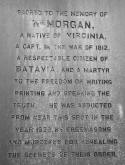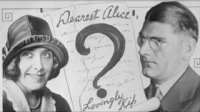Breanna Boss. “The Power of Perception: The failure of the Morgan Trials and the Formation of the Anti-Masonic Party.” The disappearance of William Morgan on September 19, 1826 was more than just a highly publicized event within the state New York. The context surrounding Morgan’s murder and the extent of the interference of the Freemasons throughout the process of the trial illuminated the vast influence the masonic party had over society and institutions, causing a ripple of negative reaction towards the Freemasons in New York and beyond. Boss strategically and brilliantly frames her examination of anti-masonic sentiment through the retelling of the unknown last days of Morgan’s life, as well as the aftermath of his death through the trials. Using the infamous murder of William Morgan as her crux, Boss interprets and theorizes the inception of a shift in mindset within New England towards one of the oldest and most influential secret societies in North America. - Mary Goodnight.
Issue 6, Spring 2017
Editorial Board
Brittany A. Boone, Matthew C. Clark, Emily E. Cole, Alyssa B, Fisher, Mary K. Goodnight, Cassidy M. Hall, Elizabeth C. Hurd, Maeve P. Lindsey, Rebecca A. Mitchell, Franklin H. Otis, Jon T. Otto, Robert D. Smith, Rita M. Velasco, Amanda M. Venegas.
Faculty Advisor
Raphael B. Folsom
Like history itself, Issue Six of the OU Historical Journal is characterized by continuity and change over time. Several of the editors from previous editions have remained, as has the board’s commitment to excellence, fairness, and intellectual rigor. Other editors have moved on, and new authors have brought new perspectives, topics, and methods to bear. The essays we have selected are representative of the varieties of work OU history students do, with papers on legal history, the history of gender, and the history of science. Congratulations to those we publish here, and to the profs who helped bring these papers into existence. – The Editors.
Winner of the Griswold Prize for Excellence in Undergraduate Historical Scholarship

Featured Papers
Mackenzie Jentsch. “Across the Tea Table: Homosociality in the English Enlightenment.” In her capstone paper, Mackenzie Jentsch explores female relationships in 18th century England. Jentsch reveals a little-known female fraternity in an era characterized by male bonds. By means of Enlightenment ideology and gender discrimination, women were excluded from intellectual and work-related pursuits, but developed thriving female social circles as a result. Jentsch shines a light on the unique opportunity for female-to-female relationships that developed due to women’s’ social engagements predominately occurring with each other as a result of exclusion from typically male activities. Written for PROFESSOR -Maeve Lindsey
Jordan Reid. "The Disguise of Insanity: The Case of Daniel E. Sickles.” The development of the American insanity plea stems largely from the events of Daniel E. Sickles's trial in 1859 for the murder of an adulterer. Insanity at the time was a loose definition that often corresponded to unwritten moral and social codes present in 19th century America, and paved the way for the use of temporary insanity as a legal defense in American law for years to come. Written for PROFESSOR - Amanda Venegas

Colter Addington. “Edinburgh’s New Town: An Enlightened Enterprise.” This paper discusses how the Enlightenment affected Edinburgh's expansion in the eighteenth century. Leading Enlightenment figures addressed the city's needs using the principles of reason, order, and neoclassic architecture. Addington carefully places Edinburgh's growth within the context of the greater Enlightenment, as well as its British and Scottish counterparts. Readers are walked through the mind-numbing minutia of city planning with an easy to read narrative explaining the challenges faced by planners. Through his descriptive writing style, readers discover what life in eighteenth-century Edinburgh was truly like. Written for Dr. Judith Lewis. -Rita Velasco

Alyssa Fischer. "The Rhinelander Case: Making Masculinity from Manhood.” In this paper, Alyssa Fisher thoroughly examines the intriguing trial of Leonard “Kip” Rhinelander and how this much-publicized court case embodied the sentiments of the American public in regards to gender roles and identities in the 1920s. Fisher traces the marked changes that occurred in the transition between Victorian ideas about masculinity and those of the 21st century and examines the effect of these changing ideas about masculinity on the 1925 trial for the divorce of Leonard, a wealthy white man, and Alice Jones, his lower-class biracial wife. Written for Dr. Andrew Porwancher. Rebecca Mitchell
Emily Cole Nethercutt. "The Scopes Trial, Genesis, and The Nation’s Obsession with Monkeys.” In 1925, the trial of State of Tennessee v. John Thomas Scopes, more commonly known as the Scopes “Monkey” Trial, thrust the small town of Dayton, Tennessee into the national spotlight. Scopes, a local teacher, was on trial for teaching evolution to his students. In her paper, Emily Cole Northcutt describes how the attorneys used the trial to debate the places of science and religion in public education. She argues that the trial demonstrates modern scholasticism’s obsession of reconciling the Bible with evolutionary theory. She also discusses how the trial’s complex legacy has helped cement its spot in American history. Written for PROFESOSR.- Cassidy Hall
Honorable Mention
Maeve Lindsey/Glenn Matthews: “Conspiratorial Fears and Constitutional Threats.”
Paige Colston. “The Folly of Bradwell v. Illinois.”
Marisa Kometas. “A Perfect Storm: How Economic Factors Precipitated the Rise of the Slave System in the Southern North American Colonies, 1607-1775 AD.”
Sharon Bozorgi. “Symbolic Liturgical Connections and Popular Veneration in Late Antiquity.”
Rita Velasco/Margaret Collins. “Genocide by Liberal Economics? The British Response to the Irish Famine.”
Shorter Papers
Ellie Bednarek, “A Tale of Two Outcomes: How Nasser Won and Lost the Suez and Six Day Wars.”
Austin Coffey, “A Conspicuous Absence: Locke, Jefferson, Madison, and Propeorty Rights in American State Papers.”
Cody Totten. “Civil War in the Vendée: The Perpetuation of Brutality During the French Revolution.”
Special Notice For the Winner of the Maehl Prize
Maeve Lindsey. “The Devil is in the Details.”
* A note on the selection of these papers: Because our student editors are among the best students we have, the faculty advisors of the journal asked them to submit their papers under pseudonyms, such that the editorial board as a whole could consider their work in an unbiased way. Each of the submissions to the journal was read by all the editors, who selected their top ten papers. A number one vote was assigned ten points, and a number ten vote was assigned one point. The points were then aggregated, and the top vote-recipients were selected for publication. The criteria the papers were judged by can be found here.

